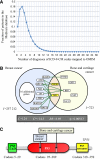The impact of cellular networks on disease comorbidity
- PMID: 19357641
- PMCID: PMC2683720
- DOI: 10.1038/msb.2009.16
The impact of cellular networks on disease comorbidity
Abstract
The impact of disease-causing defects is often not limited to the products of a mutated gene but, thanks to interactions between the molecular components, may also affect other cellular functions, resulting in potential comorbidity effects. By combining information on cellular interactions, disease-gene associations, and population-level disease patterns extracted from Medicare data, we find statistically significant correlations between the underlying structure of cellular networks and disease comorbidity patterns in the human population. Our results indicate that such a combination of population-level data and cellular network information could help build novel hypotheses about disease mechanisms.
Conflict of interest statement
The authors declare that they have no conflict of interest.
Figures



Similar articles
-
Identification of disease comorbidity through hidden molecular mechanisms.Sci Rep. 2016 Dec 19;6:39433. doi: 10.1038/srep39433. Sci Rep. 2016. PMID: 27991583 Free PMC article.
-
Genetic and functional characterization of disease associations explains comorbidity.Sci Rep. 2017 Jul 24;7(1):6207. doi: 10.1038/s41598-017-04939-4. Sci Rep. 2017. PMID: 28740175 Free PMC article.
-
Exploring disease comorbidity in a module-module interaction network.J Bioinform Comput Biol. 2020 Apr;18(2):2050010. doi: 10.1142/S0219720020500109. J Bioinform Comput Biol. 2020. PMID: 32404015
-
The implications of human metabolic network topology for disease comorbidity.Proc Natl Acad Sci U S A. 2008 Jul 22;105(29):9880-5. doi: 10.1073/pnas.0802208105. Epub 2008 Jul 3. Proc Natl Acad Sci U S A. 2008. PMID: 18599447 Free PMC article. Review.
-
Network-based methods for human disease gene prediction.Brief Funct Genomics. 2011 Sep;10(5):280-93. doi: 10.1093/bfgp/elr024. Epub 2011 Jul 15. Brief Funct Genomics. 2011. PMID: 21764832 Review.
Cited by
-
Data-driven comorbidity analysis of 100 common disorders reveals patient subgroups with differing mortality risks and laboratory correlates.Sci Rep. 2022 Nov 2;12(1):18492. doi: 10.1038/s41598-022-23090-3. Sci Rep. 2022. PMID: 36323789 Free PMC article.
-
Non-Coding RNAs Extended Omnigenic Module of Cancers.Entropy (Basel). 2024 Jul 27;26(8):640. doi: 10.3390/e26080640. Entropy (Basel). 2024. PMID: 39202109 Free PMC article.
-
Network biology concepts in complex disease comorbidities.Nat Rev Genet. 2016 Oct;17(10):615-29. doi: 10.1038/nrg.2016.87. Epub 2016 Aug 8. Nat Rev Genet. 2016. PMID: 27498692 Review.
-
LDGIdb: a database of gene interactions inferred from long-range strong linkage disequilibrium between pairs of SNPs.BMC Res Notes. 2012 May 2;5:212. doi: 10.1186/1756-0500-5-212. BMC Res Notes. 2012. PMID: 22551073 Free PMC article.
-
Towards finding the linkage between metabolic and age-related disorders using semantic gene data network analysis.Bioinformation. 2016 Jan 31;12(1):22-7. doi: 10.6026/97320630012022. eCollection 2016. Bioinformation. 2016. PMID: 27212841 Free PMC article.
References
-
- Albert R (2005) Scale-free networks in cell biology. J Cell Sci 118: 4947–4957 - PubMed
-
- Almaas E (2007) Biological impacts and context of network biology. J Exp Biol 210: 1548–1558 - PubMed
-
- Alon U (2007) Network motifs: theory and experimental approaches. Nat Rev Gen 8: 450–461 - PubMed
-
- Barabási A-L, Oltvai ZN (2004) Network biology: understanding the cell's functional organization. Nat Rev Gen 5: 101–113 - PubMed
-
- Basso K, Margolin AA, Stolovitzky G, Klein U, Della-Favera R, Califano A (2005) Reverse engineering of regulatory networks in human B cells. Nat Genet 37: 382–390 - PubMed
Publication types
MeSH terms
Grants and funding
LinkOut - more resources
Full Text Sources

